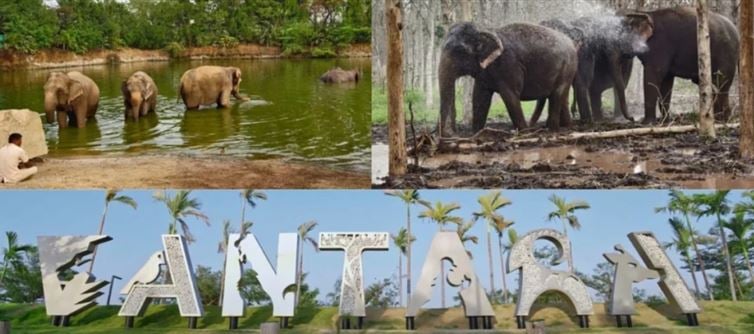
🐾 Inside Vantara: The Billionaire Zoo That May Be the Largest Wildlife Trafficking Operation in History
Behind the glossy façade of “rescue and rehabilitation” lies a global scandal that could dwarf every wildlife crime ever exposed.
1. A Secret Cargo of Chimps Sparks a Global Storm
It all began with ten chimpanzees — quietly flown out of the democratic republic of congo to india in early 2025. No fanfare. No transparency. No trace of legitimacy. What appeared to be a small zoo transfer has now exploded into one of the most jaw-dropping wildlife trafficking investigations of the century.
Investigators from the 30 Million Friends Foundation discovered that this wasn’t an isolated event — it was the tip of a sprawling, multinational operation with tentacles stretching from Africa to europe to the Middle East.
2. The Billionaire, the oil Empire, and the Hidden Zoo
At the heart of the scandal stands Anant Ambani, son of Asia’s richest man, Mukesh Ambani, and his brainchild: the Vantara Zoological Complex — a 1,400-hectare, non-public “rescue” sanctuary nestled inside the world’s largest oil refinery.
Funded by reliance Industries and the reliance Foundation, Vantara presents itself as a haven for endangered animals. But what if it’s something far darker?
Behind the glossy branding and philanthropic messaging lies a growing pile of evidence suggesting tens of thousands of animals — over 50,000 — may have been trafficked into india under the guise of conservation.
3. The Data That Shook the Conservation World
By analyzing global customs data, investigators uncovered an unthinkable pattern:
Between May 2022 and september 2025, more than 50,000 live animals — mammals, reptiles, birds, and amphibians — were shipped to one destination: Vantara.
Imports surged from 137 in 2022 to over 30,000 in 2024, raising one screaming question: how can one zoo possibly house so many creatures ethically or legally?
4. The Global Network of “Shadow Exporters”
The report exposes a disturbing trade web:
United Arab Emirates — main exporter, despite having no native apes or big cats.
Congo and South Africa — suspected of funneling illegally captured great apes, lions, and leopards.
EU countries — Germany, the Czech Republic, Belgium, and even france contributed to the animal influx, sometimes ignoring conservation warnings.
Asia’s wildlife hotspots — Indonesia, Malaysia, and thailand — are now implicated in supplying massive shipments of birds, reptiles, and primates.
Each shipment blurs legality under CITES, the international wildlife trade treaty, with “captive-bred” certificates masking what activists call industrial-scale laundering of wild-caught animals.
5. The Smoking Gun: Missing, Misdeclared, and Mysterious Animals
The discrepancies are staggering. Customs records from exporting countries don’t match indian import logs. Some shipments list “unknown origin.”
Others falsely claim animals came from “breeding farms” that don’t exist.
In one jaw-dropping instance, 4,500 animals were shipped from the uae in a single convoy. Another, from Indonesia, carried 2,500 wild species in one go.
Experts believe mass harvesting from the wild is ongoing — endangering entire populations of species already on the brink.
6. CITES Confirms the Worst: india Under Fire
On October 31, 2025, the CITES secretariat released its findings, confirming massive traceability failures in India’s import processes.
Animals declared as captive-bred could have easily been wild-caught.
The report accuses indian authorities of negligence, lack of verification, and enabling systemic wildlife laundering.
Even worse — despite claiming to be a “non-commercial rescue,” Vantara is suspected of paid transactions and receiving invoices for animal shipments.
7. Conservationists Are Furious — and Terrified
From Africa’s sanctuaries to Europe’s wildlife agencies, experts are calling this the “largest coordinated laundering of wildlife ever documented.”
Dr. Mark Jones of Born Free asks:
“Why import thousands of animals from across the planet if you claim to be rescuing them? Why the secrecy? Why the money?”
Even CITES questions whether Vantara is more a private collection than a conservation project — one that may have turned the global wildlife crisis into a billionaire’s vanity exhibit.
8. The Public Relations Mirage
When indian Prime minister Narendra Modi personally attended Vantara’s inauguration — feeding lion cubs and orangutans for cameras — it seemed like a national triumph.
But activists say this event was the epicenter of greenwashing:
A humanitarian PR campaign masking mass exploitation, ecological damage, and possible wildlife smuggling at a scale never seen before.
9. The european union and Global Watchdogs Step In
The 30 Million Friends Foundation has now presented its dossier to european and French authorities, demanding immediate international intervention.
With the CITES Conference of the Parties convening in uzbekistan in late 2025, the scandal is set to dominate the agenda — forcing global leaders to answer one burning question:
Is Vantara a rescue project or the world’s biggest wildlife laundering empire?
10. What Comes Next: Justice or Cover-Up?
With tens of thousands of animals missing, unaccounted for, or possibly dead, the stakes couldn’t be higher.
Vantara stands accused of weaponizing conservation for prestige — turning endangered wildlife into corporate trophies.
Unless immediate international oversight intervenes, the next generation may inherit not zoos full of animals, but empty cages and extinct species.
🔍 Source: 30 Millions d’Amis Foundation Investigative Report, 2025
🐾 Partner Organizations: Born Free, EAGLE Network, Global Animal Law Coalition
⚠️ Disclaimer: The following article is based on investigative findings originally published by 30 Millions d’Amis Foundation, which has led a detailed international probe into the alarming global wildlife trafficking scandal allegedly connected to the Vantara Zoological Complex in India.




 click and follow Indiaherald WhatsApp channel
click and follow Indiaherald WhatsApp channel